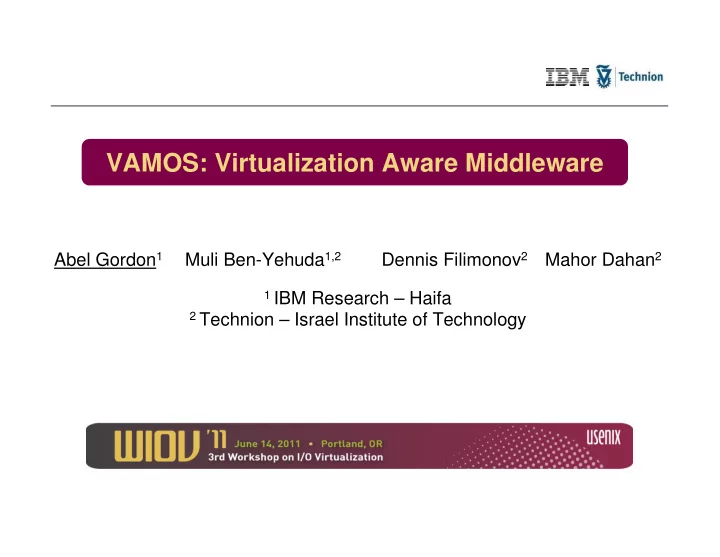

VAMOS: Virtualization Aware Middleware Abel Gordon 1 Muli Ben-Yehuda 1,2 Dennis Filimonov 2 Mahor Dahan 2 1 IBM Research – Haifa 2 Technion – Israel Institute of Technology
VAMOS – WIOV 2011 VAMOS: Virtualization Aware Middleware � Virtualization overhead is still high due to the transitions between the guest and the hypervisor � Motivation: potential optimizations at the application layer have been ignored – Software is still built based on models that apply to non-virtual systems – Applications are not being adapted for the underlying “virtual” platform – No cooperation between the application and the hypervisor – Adapting the middleware such as Databases, Web Servers, Application Servers to virtualized platforms we can indirectly adapt many applications and regain lost performance �
VAMOS – WIOV 2011 I/O virtualization with KVM, a long way down…. ���������������� Unexplored ���� ������������������ ������ ��������� �������� ������ � ������������� ������������� ���������� ����������� ����� ���������� Explored ����� ������������� ������������ ������� ���������� ������ ������������������������������� �
VAMOS – WIOV 2011 VAMOS Goals � Reduce virtualization overhead by adding virtualization awareness to the middleware � Avoid changes in the guest operating system � Re-use/re-factor existent code by exploiting modularity � Avoid software re-write/re-design �
VAMOS – WIOV 2011 ����� ����� Application Application Middleware Middleware Module A Module B Module C Module A Module B OS OS �����!���� �����!���� VMM VMM Virtual Hardware Virtual Hardware Emulation Emulation Middleware Physical Hardware Physical Hardware Module C Manager Manager Physical Hardware Physical Hardware Traditional VAMOS Architecture Architecture �
VAMOS – WIOV 2011 Middleware Adaptation Middleware Module A Module B Module C 1. Modules which interact directly with system resources, generating many transitions to the hypervisor context and requiring emulation of virtual hardware 2. Modules which can be easily re-factored into a client side running in the guest and a server side running in the host 3. Modules which do not share state with other components, avoiding data sharing and synchronization between the guest and the hypervisor. 4. Modules that do not require persisted state at the hypervisor level (do not require special handling for live-migration, checkpoint/restore) �
VAMOS – WIOV 2011 VAMOS Requirements 1. A runtime environment: � Isolated � At the hypervisor level � Executing middleware code � With access to physical resources, such as network devices or disk drives – Most hypervisors have a general purpose OS 2. A communication channel between: � the middleware running in the guest � the middleware running in the host � the hypervisor – Para-virtualization channels are commonly used �
VAMOS – WIOV 2011 Looking for the right balance VAMOS Para-Virtualization Low Performance High Performance Loose Coupling Tight Coupling SR-IOV Unmodified I/O Pass-through Guests �
VAMOS – WIOV 2011 MySQL Software Architecture �
VAMOS – WIOV 2011 VAMOS for MySQL ����� ��"�� ���!�� ������ "����#����#��� Virtio guest Virtio $�������� middleware front-end connector ������������ ���� ����������������������� ������ "����#����#��� Virtio host Virtio %������� middleware back-end connector ����!������� Host File System ��
VAMOS – WIOV 2011 Guest/Host – Cycles Distribution Experimental setup for different row sizes • Guest cycles: still the same • Host cycles: significantly reduced ��
VAMOS – WIOV 2011 Runtime Improvement Tradeoff between amount of data and number of switches: • VAMOS: number of switches depends on the request type • Virtio: number of switches depends on the amount of data ��
VAMOS – WIOV 2011 Related Work � Virtual Interface – Xen [Barham03] – HPC [Gavrilovska08] – Virtio [Rusell08] � OS Interface – VirtFS [Jujjuri10] – Libra [Ammons07] � Hardware Interface – SR-IOV [Dong08, Liu10] � VAMOS takes virtualization awareness up into userspace (Middleware) ��
VAMOS – WIOV 2011 Conclusions & Future Work � Virtualization overhead is still high due to the transitions between the guest and the hypervisor � Running part of the middleware at the hypervisor level, VAMOS reduces the overall number of guest/hypervisor switches and improves I/O performance � Exploiting existing modular designs and abstraction layers, middleware can be adapted to run at the hypervisor level with modest cost � VAMOS presents a new design point to be considered in the [transparency vs. performance] trade-off spectrum � Next Steps: – Apply VAMOS to other middleware – Explore additional areas such as memory over-commit – Analyze feasibility of building a common infrastructure shared across different middleware – Improve middleware isolation and security – Guest/Host communication optimizations – What can we do if we re-think the middleware from scratch ? ��
VAMOS – WIOV 2011 Questions ? ��
Recommend
More recommend